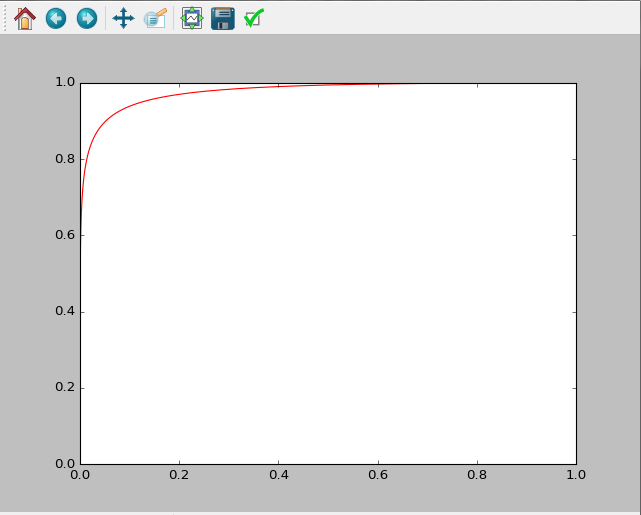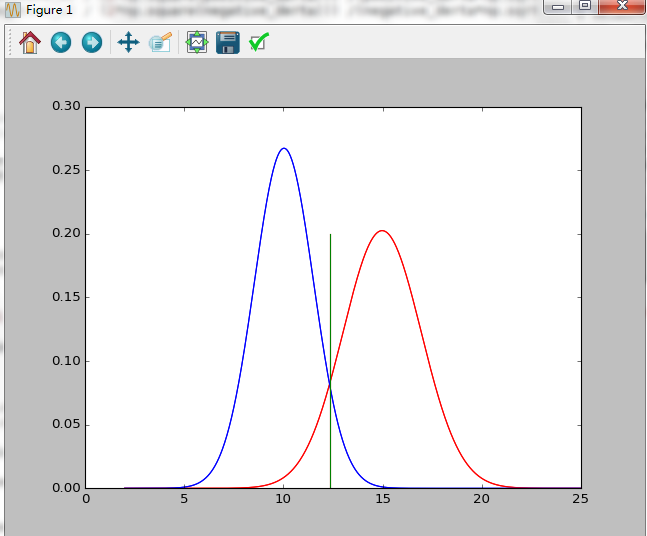对于二分类问题,它的样本只有正样本和负样本两类。测试样本中,正样本被分类器判定为正样本的数量记为TP(true positive),被判定为负样本的数量记为FP(false negative)。负样本被分类器判定为负样本的数量记为TN(true negative),被判定为正样本的数量记为FP(false positive)。如图所示,A,B两组样本总数量各为100。

精度定义: TP/(TP+FP)
召回率定义:TP/(TP+FN)
虚景率: 1 - TP/(TP+FP)
真阳率:TPR =TP/(TP +FN)
假阳率:FPR = FP/(FP+TN)
ROS曲线的横轴为假阳率,纵轴为真阳率。
一个好的分类曲线应该让假阳率低,真阳率高,理想情况下应该是接近于y=1 的直线,即让曲线下的面积尽可能的大。
例子:
生成两组正态分布样本,两组样本对应的标签分别表示正样本,和负样本;资源链接如下:
链接:https://pan.baidu.com/s/1X4hHygzSQHB3f8_kepxE8A
提取码:6uvg
# -*- coding: utf-8 -*- """ Spyder Editor This is a temporary script file. """ import numpy as np import matplotlib.pyplot as plt from scipy import stats def floatrange(start,stop,steps): return [start+float(i)*(stop-start)/(float(steps)-1) for i in range(steps)] """读取数据""" data = np.loadtxt('data.txt') """"计算不同类别的正态参数""" totalCount = len(data[:,0]) positiveCount =np.sum(data[:,1]) negativeCount = totalCount - positiveCount #正标本均值,方差 positiveIndex= np.where(data[:,1] ==1) positiveSum = np.sum(data[positiveIndex,0]) positive_u =positiveSum / positiveCount positive_derta =np.sqrt(np.sum(np.square(data[positiveIndex,0] - positive_u )) / positiveCount) #负标本均值,方差 negativeIndex= np.where(data[:,1] ==0) negativeSum = np.sum(data[negativeIndex,0]) negative_u =negativeSum / negativeCount negative_derta =np.sqrt(np.sum(np.square(data[negativeIndex,0] - negative_u )) / negativeCount) #概率密度 曲线绘制 x = floatrange(2,25,1000) print(positive_u,positive_derta) pd = np.exp(-1.0*np.square(x-positive_u) / (2*np.square(positive_derta))) /(positive_derta*np.sqrt(2*np.pi)) nd = np.exp(-1.0*np.square(x-negative_u) / (2*np.square(negative_derta))) /(negative_derta*np.sqrt(2*np.pi)) plt.figure(1) plt.plot(x,pd,'r') plt.plot(x,nd,'b') #概率分布构建 positiveFun = stats.norm(positive_u,positive_derta) negativeFun = stats.norm(negative_u,negative_derta) positiveValue = positiveFun.cdf(x) negativeValue = negativeFun.cdf(x) #真阳率,假阳率 positiveRate = 1 -positiveFun.cdf(x) negativeRate = 1 -negativeFun.cdf(x) #阀值 disvalue =positiveFun.cdf(x) +1 -negativeFun.cdf(x) minvalue = np.min(disvalue) index = np.where(disvalue == minvalue) indexvalue =int(index[0]) xvalue = x[indexvalue] #混淆矩阵 positivevalue = 1 -positiveFun.cdf(xvalue) negativevalue = 1 -negativeFun.cdf(xvalue) v00= int(positivevalue * positiveCount) v01= positiveCount -v00 v10 =int(negativevalue* negativeCount) v11 =negativeCount -v10 print("disvalue:",xvalue) print("positiverate:",positivevalue,"negativerate:",negativevalue) print(v00,",",v01) print(v10,",",v11) xdis = [xvalue,xvalue] ydis = [0,0.2] plt.plot(xdis,ydis,'g') """ros 曲线""" plt.figure(2) plt.plot(negativeRate,positiveRate,'r')
运行结果如下所示:

